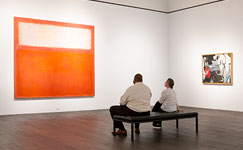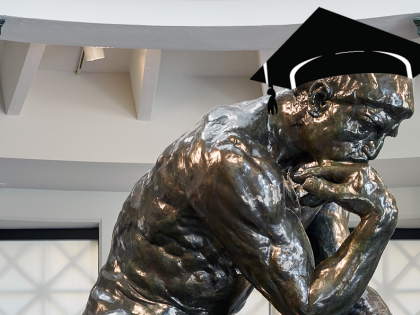A new start for art at Stanford: Cantor Arts Center and Anderson Collection reopen
Sheryl Nonnenberg
7-8 minutes
After more than a year of closure, Stanford University’s major art museums — Cantor Arts Center and the Anderson Collection at Stanford — are open again. A visit to campus reveals that, while some things have remained the same (the venerable Rodin sculpture collection, for example), there have been some significant changes at both museums since they last welcomed in-person visitors.
In addition to current health policies such as mask mandates, timed tickets and social distancing rules, perhaps the most notable difference can be found at the Cantor, which is now being led by two interim directors, Elizabeth Mitchell and Maude Brezinski. Mitchell, who is the curator of prints, drawings and photographs, has worked at the museum since 2010. Brezinski is the executive director of development for the arts and has led capital campaigns and annual giving programs at the university for more than 20 years. She played a key role in fundraising efforts for the university’s arts district, which encompasses the two museums, the Bing Concert Hall and the McMurtry Building for Art and Art History.
They were appointed last fall after the departure of former director Susan Dackerman. A lengthy investigation, begun after an exposé in the Stanford Daily, revealed a toxic work culture at the museum and ended with Dackerman’s resignation in late November. The university has been circumspect about personnel matters, but did issue a press release at the time indicating that a transition team “will work closely with stakeholders from across the campus and community to situate the museum for ongoing success.”
Mitchell and Brezinski discussed their new roles and goals in recent email interviews with this news organization.
When asked if the Cantor is emulating the administration model of numerous large museums, such as the Metropolitan Museum of Art in New York, in having two directors — one with management background and one with curatorial expertise — Brezinski responded, “Cantor is using a similar model with the exception that we both closely align with one another in our areas of expertise. The advantage for this current arrangement is that both of us have a long tenure at Stanford/Cantor and understand its history.” Mitchell noted, “It has been very useful for us each to tap into our different spheres of experience to connect with staff and work toward institutional goals.”
Both indicated that, in addition to their respective skills and experience, just having an extensive history at Stanford has been a major advantage.
“My Stanford colleagues have helped weigh in on a variety of issues from legal documents to instituting timed ticketing for the first time,” Brezinski said. “Also, knowing our donors and volunteers has been very rewarding, as they have been incredibly supportive and encouraging.” Mitchell, who served on staff-led committees that addressed the work culture at the museum, noted, “These experiences have helped me thoroughly understand the challenges faced by the museum team in their daily work, and areas in which staff want the museum to grow and flourish.”
And how do they plan to address the issues raised last summer?
“We are working closely with the staff with goals of transparency, empowerment and open communications,” according to Brezinski. For Mitchell, that means talking regularly with staff “to understand what tools and information they need to be successful in their work, and we use that feedback to strengthen communication and collaboration across the museum.”
Neither would comment on the status of the search for a permanent new museum director but Matthew Tiews, interim senior associate vice president for the arts, said the university “will launch a search for the next director of the Cantor Arts Center in the next few months.”
During the closure, the museums made considerable efforts to remain relevant via virtual offerings, including online exhibitions, tours and lectures. Jason Linetzky, director of the Anderson Collection, said, “The closure provided opportunities for the museums to develop digital content and tours and present virtual programs with contemporary artists, museum docents and Stanford Student Guides.” At the Cantor, according to Brezinski, the closure also allowed the staff to spend time planning for the future.
“Exhibition scheduling has also been robust and we will publicize future exhibitions soon. Our membership has been affected, but in comparison to our peers, we have maintained a very good base. Aside from the resignations that occurred last fall/early winter, the staff has remained very stable,” she said.
There have also been changes in the past few years for the Anderson Collection, mainly the deaths of founders “Hunk” and “Moo” Anderson. According to Linetzky, their passing has only strengthened the museum’s commitment to sharing the collection and expanding educational opportunities. Only the first floor of the Anderson is currently open, including the installation “Hostile Terrain 94” and “Formed and Fired: Contemporary American Ceramics,” while the permanent collection upstairs is packed for temporary storage. The entire museum will be closed again starting May 3 so that gallery ceilings can be resurfaced, the galleries repainted and the permanent collection reinstalled for an autumn reopening. The temporary gallery on the lower level will then feature the acrylic and resin sculptures of Sam Richardson, who was a highly respected minimalist sculptor and professor of art at San Jose State University.
At the Cantor, among its selection of ongoing and temporary exhibitions, the special exhibition “When Home Won’t Let You Stay: Migration through Contemporary Art” is on view through May 31. Richard Serra’s sculpture Sequence and the Rodin Sculpture Garden are still available to those who prefer an outdoor encounter with art. Outdoor dining at Cool Cafe has not yet returned but, according to the museum’s website, will soon be announced.
All three museum directors are happy to be engaging with the public and encouraging in-person experiences with their collections again. When asked what she wants the community to know about visiting the museum, now and in the future, Brezinski replied, “We want them to feel that it is their second home — that they are welcomed, that they will see beautiful art and learn from our curators, program staff, faculty, docents and volunteers.”
The museums are currently open Wednesday through Sunday from 11 a.m. to 5 p.m. at 25% capacity. Free, timed tickets are required. For more information about updated visitor guidelines and policies, go to the museum’s websites: museum.stanford.edu and anderson.stanford.edu.






